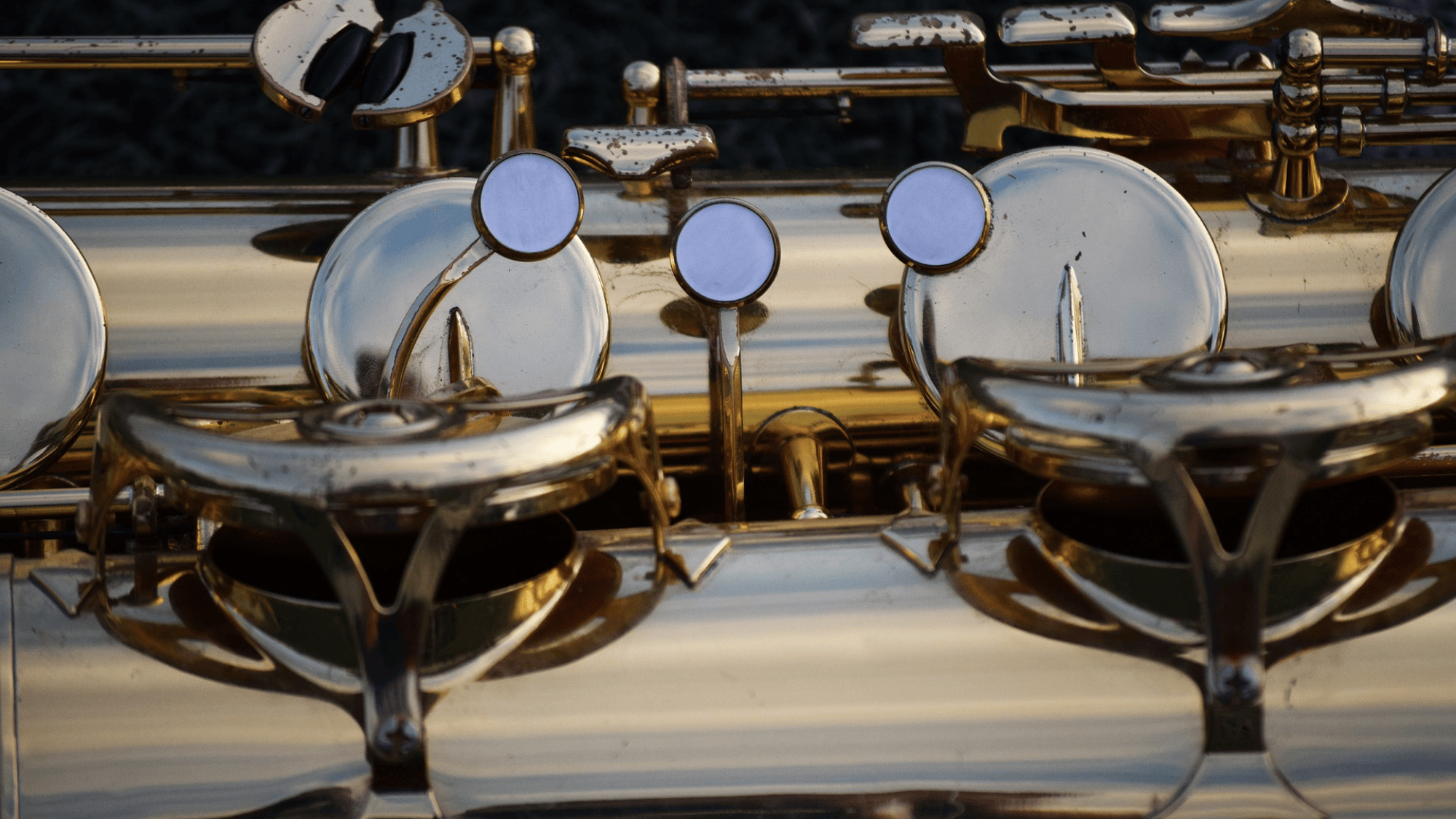Setting up the percussion section
Every conductor has experienced it: rehearsal is progressing smoothly, then the triangle part is missing. “Who is playing the triangle?” “Umm…we didn’t know we needed it.” Or “We can’t find it,” your percussionists reply.
There are three keys to solving this dilemma:
- Students must be able to quickly and easily locate the instruments and equipment they need,
- Students must know what they need and when they need it, and
- Students must set up their stations efficiently for each piece.
This is the third article in a three-part series addressing each of the keys to success. In this installment, we examine how the physical setup of the percussion instruments affects students’ performance and effective methods to maximize efficiency and musical results. Many conductors follow a traditional model of setup for percussion instruments in wind bands. Typically this would feature the timpani on the conductor’s right, followed by the bass drum and then the snare drum close to the middle of the ensemble. Cymbals and an accessories station often come next, with a long row of keyboard instruments stretching out around the ensemble to the conductor’s left.
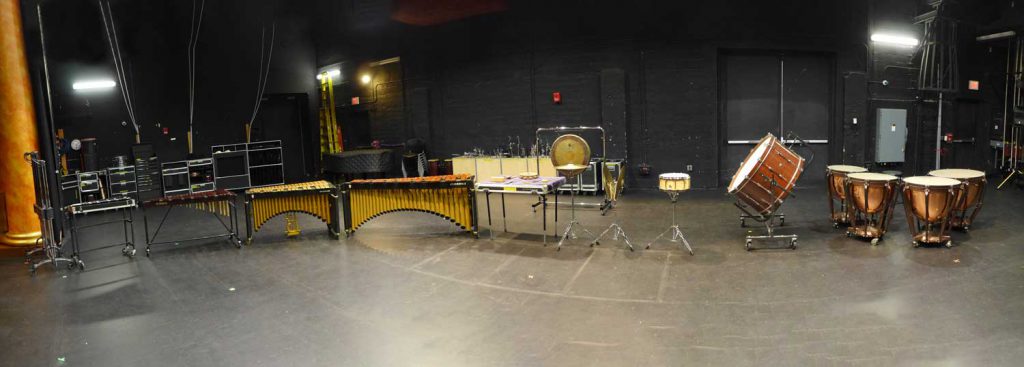
This setup is traditional for several good reasons:
1. It keeps the timpani near where tubas would typically be seated,
2. It places the bass drum (also a bass voice) near the timpani and tubas as well,
3. The placement of the bass drum and snare drum near the center of the ensemble helps promote stability of time as all instrumentalists can hear them easily, and
4. Keyboards wrap around the areas where trumpets and clarinets are often placed, which is advantageous when they play similar parts.
When rehearsing and performing music with very traditional percussion writing, the traditional model of setup works well. By “traditional percussion writing” we refer to percussion parts where one performer plays one instrument. For example, a part for snare drum, a part for xylophone, a part for cymbals, and so on. In this type of scoring, it would be common for there to also be a part for accessories designed to be performed by one or perhaps two players. Many works for wind band feature this type of writing and, as a result, this setup will work for all of those pieces.
The traditional setup fails when programming music with more modern percussion scoring. Since Vincent Persichetti’s “Symphony for Band” (Symphony No. 6), Op. 69 (1956), more and more composers are writing percussion parts best approached as though each part was a multi-percussion solo or setup. In “Symphony for Band,” Persichetti scores for timpani and three percussion parts, and each of the three parts contains several instruments.
This type of writing for percussion is very common in wind band music composed since the 1980s, especially in grade 4/5/6 literature. Of course, there are times when conductors may decide to split or share parts with more than one performer. See Part 2 of this series for more on best practices when assigning parts. Assuming the piece will be performed as the composer intended with one player per part, using the traditional percussion setup creates many challenges that are difficult if not impossible to overcome. With the instruments grounded in their traditional positions, players will be running back and forth across the rear of the ensemble throughout the piece. They will require multiple copies of each part (or will need to carry their music with them, an even worse solution). Instrument changes that occur with only a few beats in between may be missed, and the flurry of activity will distract the audience from the performance.
The solution is simple: move the instruments as needed for each piece being rehearsed and performed. While simple, this concept can be hard to explain to students. During one band clinic, I once saw a percussionist constantly running between the marimba and the xylophone, going around the vibes each time. I asked the student: “Why don’t you move the xylophone and the marimba next to each other?” The student simply hadn’t considered that as an option. We laughed together when I jokingly remarked “They are on wheels for a reason.” In short, the lesson is: all percussion instruments can move.
During rehearsal and performance, percussionists should be encouraged to have only the instruments and equipment they are actively using on that particular piece in front of them. Instruments and equipment needed for other pieces in the rehearsal should be kept out of the way behind the percussionists, and instruments and equipment not needed at all in the rehearsal should be left stored away properly. Giving percussionists the freedom to set up the percussion section for each piece means a more efficient rehearsal and better performance. It is critical that conductors post a list of all pieces being played in the rehearsal in the correct order to allow percussionists to know what they will need and set up for each piece in succession. It also means there will be some required downtime between pieces while the percussionists move instruments as needed, including moving some that are no longer needed out of the way and retrieving others from behind them where they were staged. Some conductors use this time to talk about the piece and the composer, but in doing so the percussionists are not able to learn along with the winds. A better idea is to fill this downtime with either discussion of rehearsal goals for the winds or to intersperse relevant warm-up and technique studies that will prepare the wind section for the challenges they will face in that piece.
CASE STUDY
So how might one of these setups be arranged? Together, we will design a setup for Vortex by Dana Wilson. Vortex is scored for five percussionists, and the staves are labeled Percussion 1 through 5. Percussion 1 primarily plays timpani, and also plays bongos, a small triangle, and lion’s roar. Percussion 2 plays vibraphone, xylophone, tam-tam, and guiro. Percussion 3 plays 4 concert toms, marimba, and tam-tam. Percussion 4 plays a small wood block, bass drum, chimes (noted in the score as tubular bells), and lion’s roar. Percussion 5 plays celeste, 2 suspended cymbals (noted in the score as large and small), and lion’s roar. Wilson notes that the lion’s roar (parts 1, 4, and 5) and tam-tam (parts 2 and 3) can be shared by relevant players.
In this case, we are fortunate to have two tam-tams and don’t need to share those instruments. Further, lion’s roars are easy to build – all one needs is a concert tom with a head in which you are comfortable putting a hole, a length of string, and a washer or nut – so we will make one for each player to reduce the need to share and move back and forth.
The first step is to create the percussion assignment chart for the conductor and to include this piece on the percussion assignment chart for the players. See part 2 of this series for more on creating percussion assignment charts. (hyperlink to part 2) Here is our percussion assignment chart for Vortex:

Now that we have our instruments assigned and know exactly what we need, we can draw or sketch a setup diagram. This need not be too formal; a simple paper diagram or drawing on the white board is sufficient.
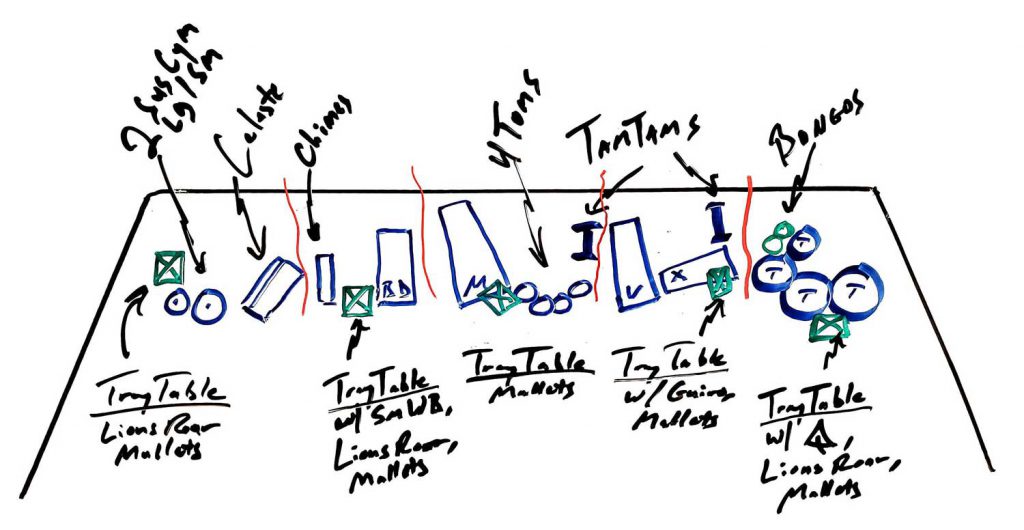
We’ve chosen to place the timpani on the conductor’s right. This keeps the timpani near the tubas, plus the timpani are the hardest to move. We include the bongos in between the 23” and 26” timpani so they can be closer to the player and reduce problems with reach. One tray table holds the triangle, beaters, and lion’s roar and a second holds timpani mallets.

To make it easier to for cuing, we can fill in percussion 2 – 5 from right to left following timpani (percussion 1). Percussion 2 is next, and an examination of the part shows more intricate rhythmic parts on the xylophone, while the vibraphone is mostly chordal. Therefore, we put the xylophone in front and the vibes off to the side so the performer can more easily see the conductor while playing xylophone. Tray tables for guiro and mallets along with a tam-tam complete this setup.
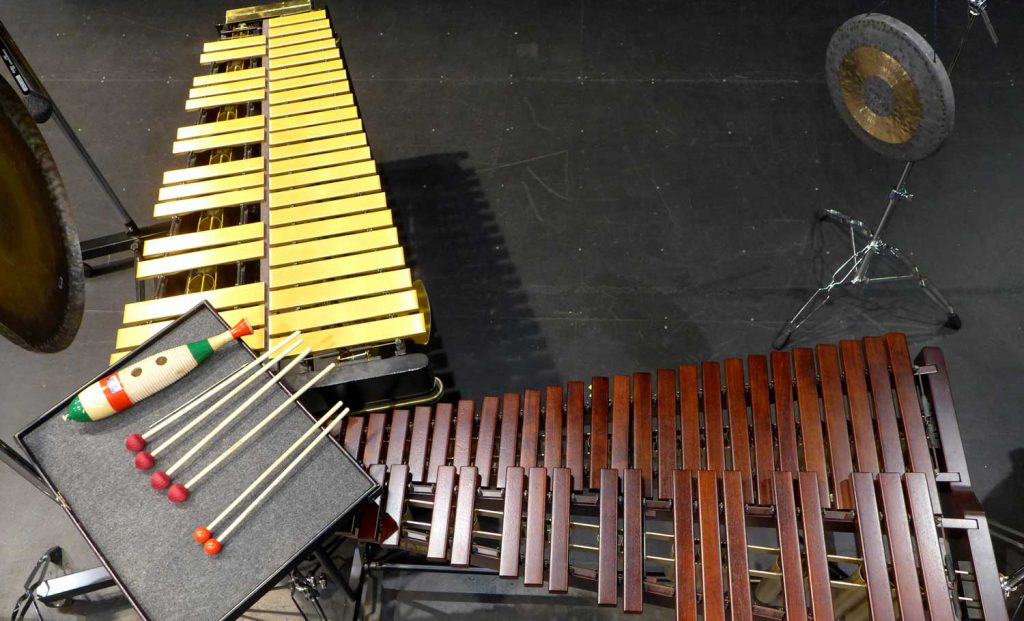
In percussion 3, the concert tom part predominates, so they are placed in front as in percussion 2. The marimba is placed at an angle to the concert toms, and the lower end can overlap the toms since it is not played in this piece. Finally, add the tam-tam and tray tables for sticks and mallets.
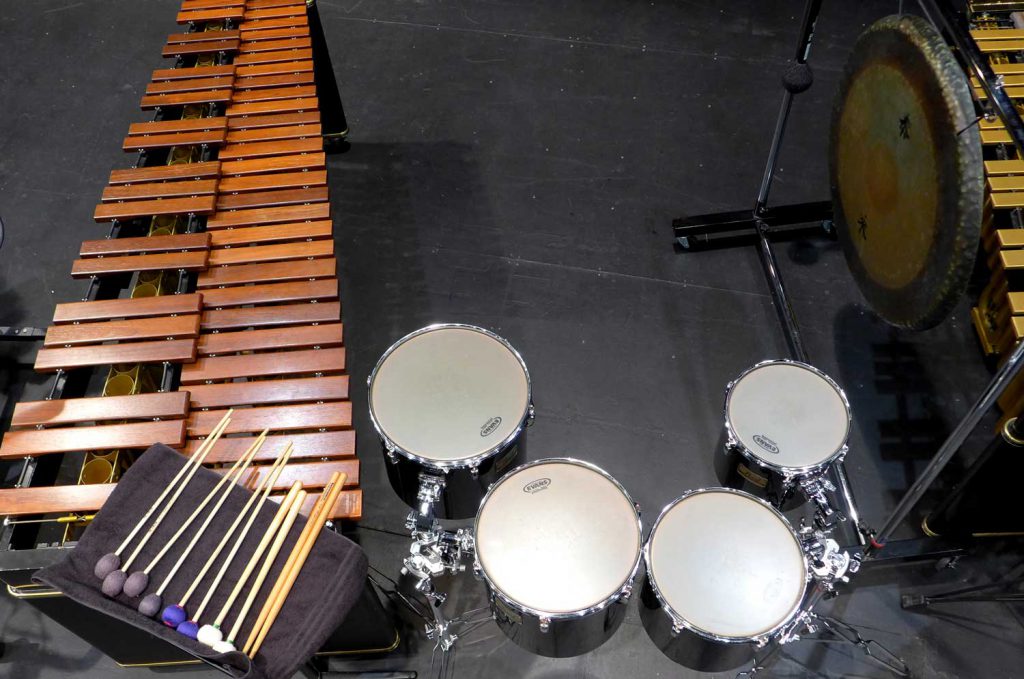
Percussion 4 plays two instruments best performed at 90 degree angles to the conductor: concert bass drum and chimes. These instruments are placed across from each other, creating a space in the middle for a tray table to hold the wood block and lion’s roar. As always, tray tables also hold bass drum and chime mallets. Music stands make great tray tables for sticks and mallets and sometimes even small accessories, but they must be first covered with hand towels to reduce noise. Hand towels can be bought in black or other dark colors for very little money at many large retailers.

Percussion 5 is an interesting part as it contains a part for celeste. First, one must assign a player with reasonable piano skills to this part. Second, few programs in schools and even many colleges and universities own a true celeste. A good keyboard with excellent sounds and an appropriate amplifier can substitute. Wilson doesn’t specify cymbal size other than large and small, so we have chosen 16” and 20” suspended cymbals for maximum timbre separation. A tray table for the lion’s roar and cymbal mallets finish this setup.

When taken altogether, the percussion section now looks very different from the traditional setup. This new arrangement makes the performance of Vortex much easier for the musicians – imagine the same piece in the traditional setup! – and much easier for the conductor. As noted previously, cuing parts becomes much easier when we respect the intended scoring by the composer. If we wanted to share parts between multiple players, we could still do that by spreading out each setup slightly to allow two players access to the instruments.
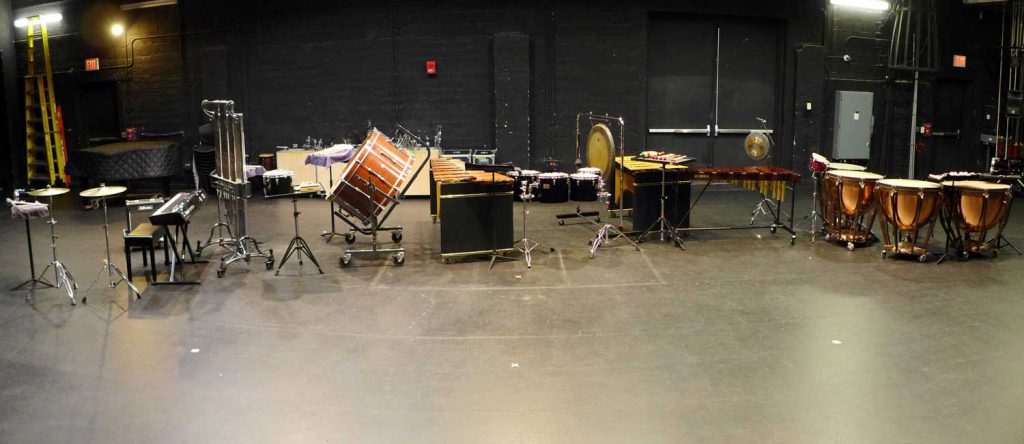
While not needed for every piece, the concept of multi-percussion stations and moving instruments will make or break the rehearsal and successful performance of others. The extra time it takes to re-arrange percussion instruments pays off in more effective use of rehearsal time and reduced load on the musicians. By assisting our young performers to understand how best to set up their section through careful planning and diagrams, we can ensure a positive musical experience for the entire ensemble.





